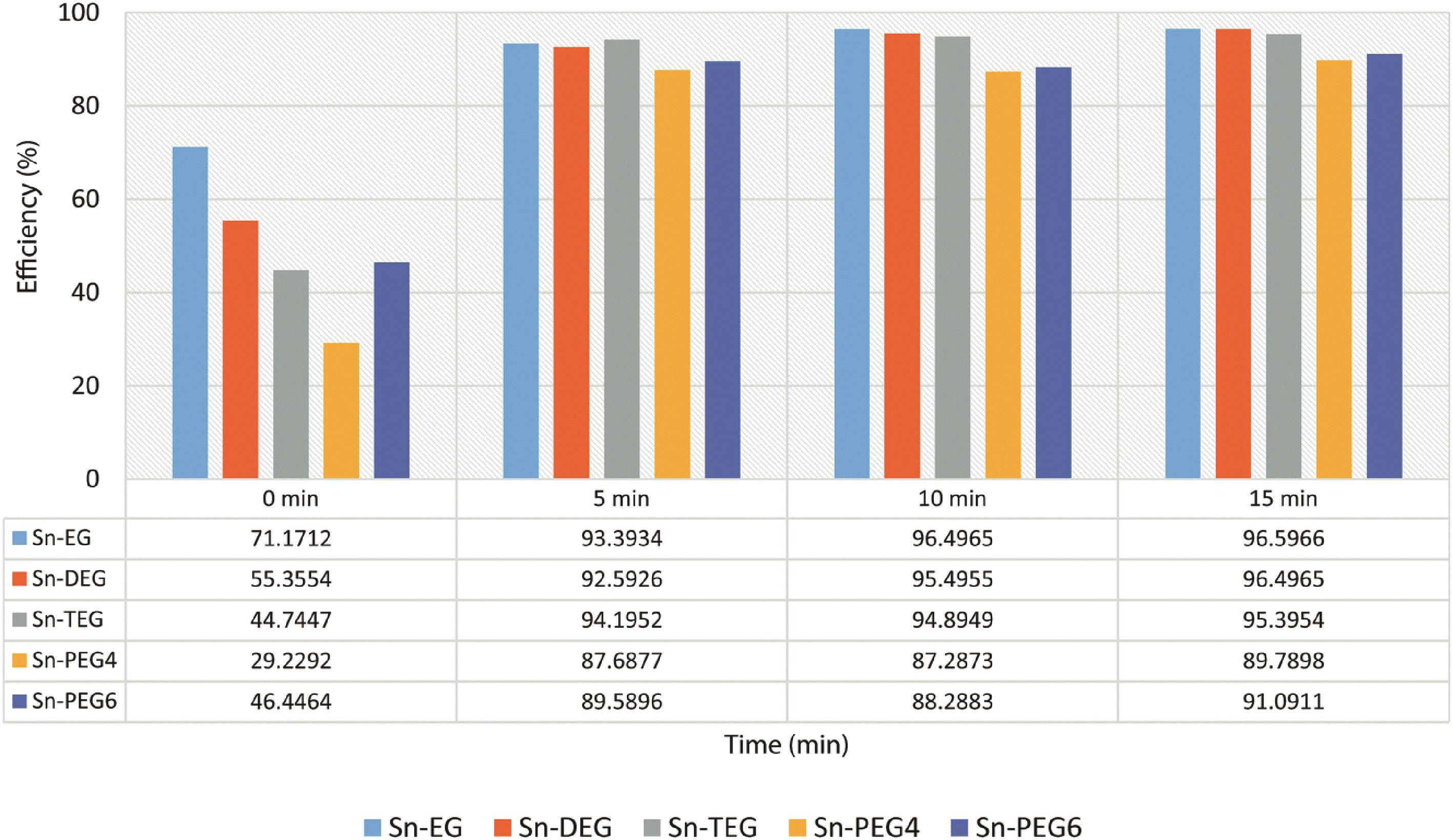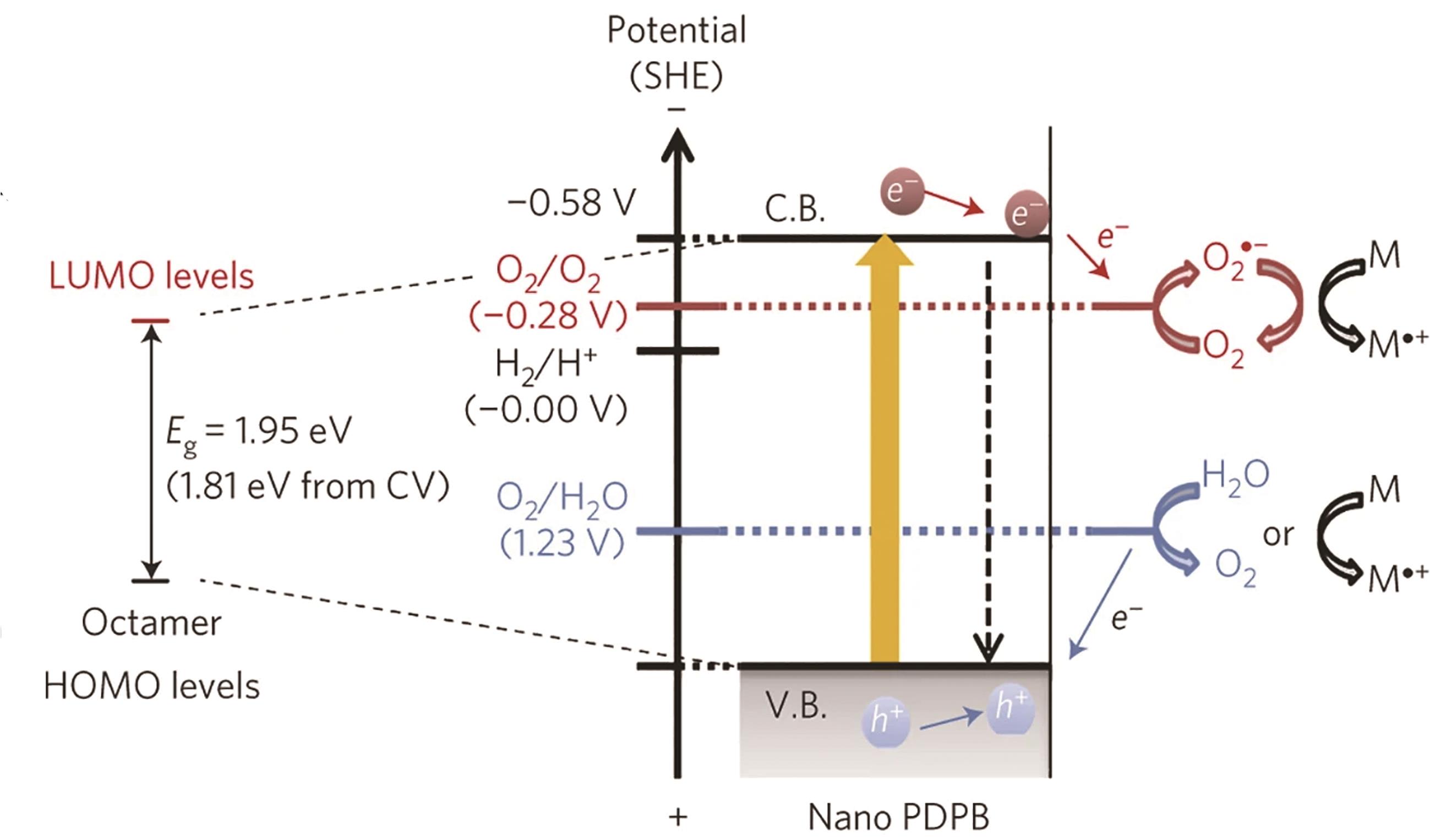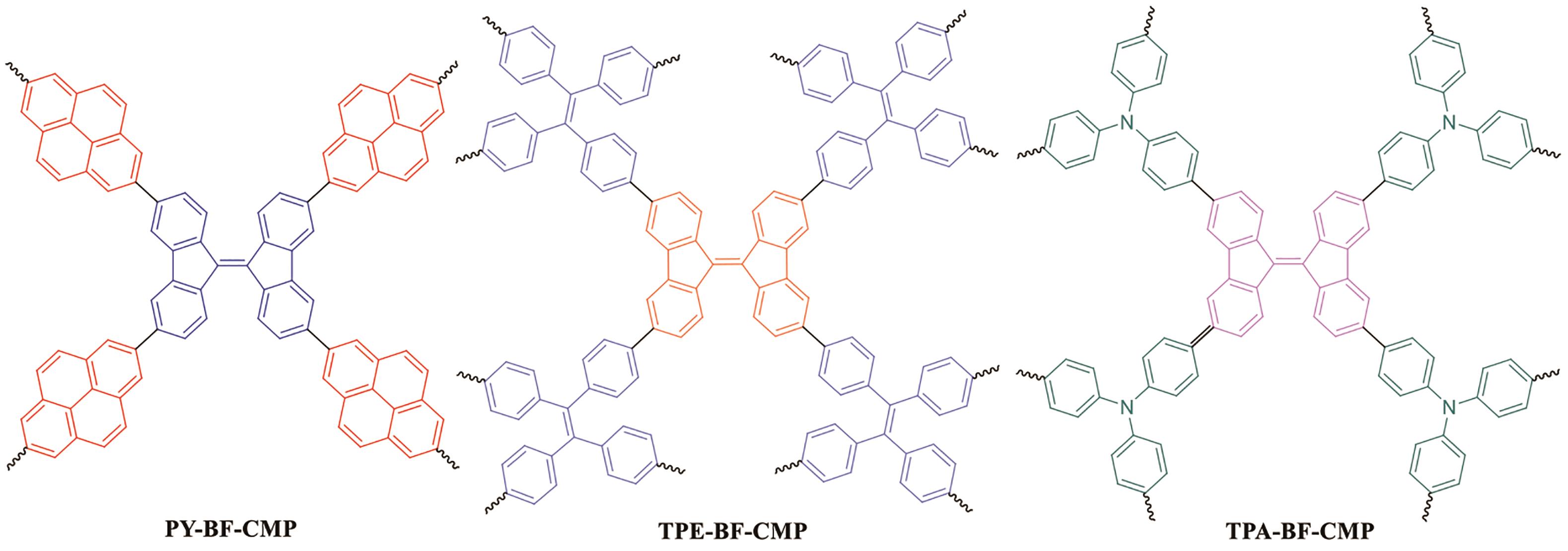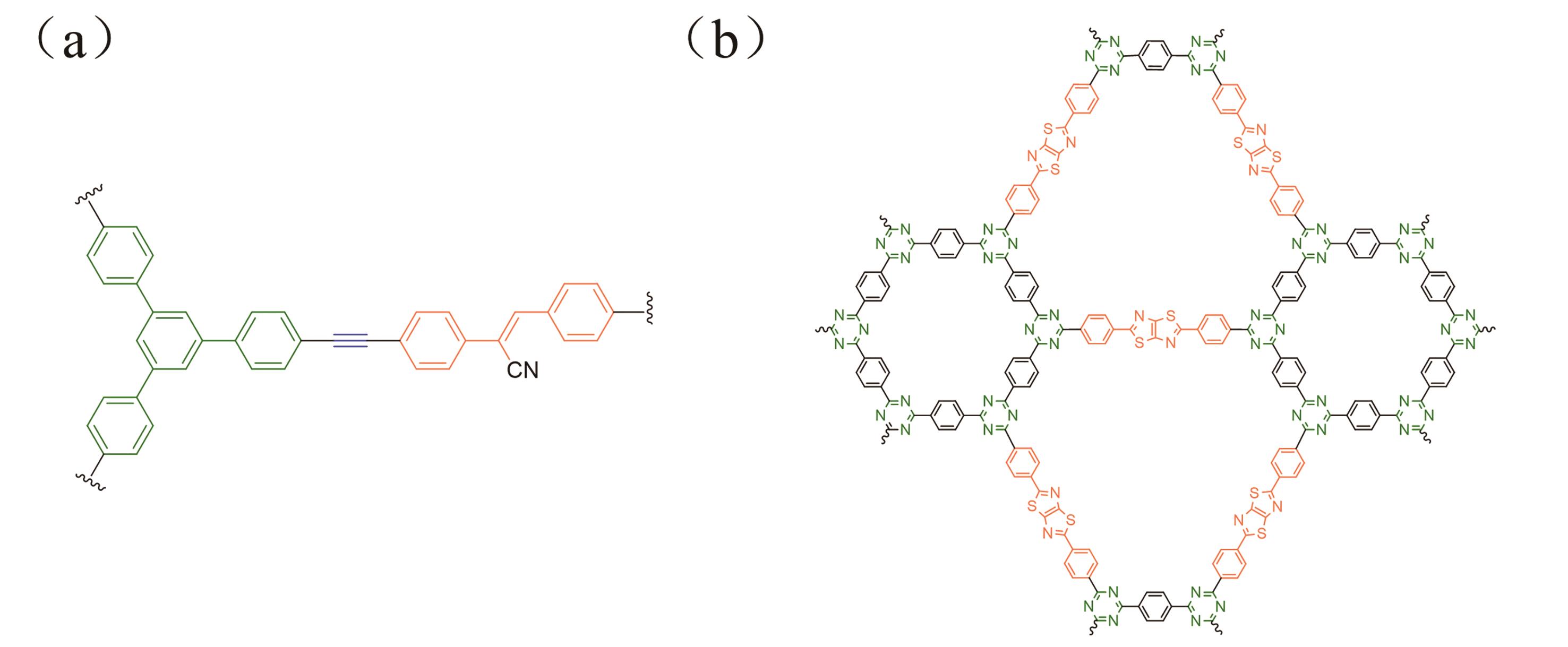
应用化学 ›› 2023, Vol. 40 ›› Issue (5): 681-696.DOI: 10.19894/j.issn.1000-0518.220335
用于降解印染废水中有机污染物的光催化剂的研究进展
雷学博1, 刘慧景1( ), 丁赫宇1, 申国栋1, 孙润军1,2
), 丁赫宇1, 申国栋1, 孙润军1,2
- 1.西安工程大学纺织科学与工程学院,西安 710048
2.西安工程大学智能纺织材料与制品国家重点实验室,西安 710048
-
收稿日期:2022-10-13接受日期:2023-03-09出版日期:2023-05-01发布日期:2023-05-26 -
通讯作者:刘慧景 -
基金资助:国家自然科学基金(21802106);中国博士后科学基金项目(2019M653860XB);陕西省自然科学基础研究计划项目(2021JQ-681)
Research Progress on Photocatalysts for Degradation of Organic Pollutants in Printing and Dyeing Wastewater
Xue-Bo LEI1, Hui-Jing LIU1( ), He-Yu DING1, Guo-Dong SHEN1, Run-Jun SUN1,2
), He-Yu DING1, Guo-Dong SHEN1, Run-Jun SUN1,2
- 1.School of Textile Science and Engineering,Xi′an Polytechnic University,Xi′an 710048,China
2.State Key Laboratory of Intelligent Textile Material and Products,Xi′an Polytechnic University,Xi′an 710048,China
-
Received:2022-10-13Accepted:2023-03-09Published:2023-05-01Online:2023-05-26 -
Contact:Hui-Jing LIU -
About author:liuhuijing@xpu.edu.cn
-
Supported by:the National Natural Science Foundation of China(21802106);the China Postdoctoral Science Foundation(2019M653860XB);the Natural Science Basic Research Program of Shaanxi(2021JQ-681)
摘要:
纺织工业印染废水的大量排放是造成水体污染物增多的主要因素之一,对人体健康和生态环境的良性循环造成严重威胁。目前,采用的物理吸附法、化学氧化法以及生物分解法等废水处理技术成本高昂、治污不彻底且容易产生二次污染,加快研发经济高效的处理技术对降低水资源消耗、保护环境意义重大。光催化降解法是催化剂受光辐照后在反应体系中产生活性自由基,自由基进一步与有机污染物反应,使其完全降解。由于该方法经济高效,不易造成二次污染,符合绿色环保的发展要求,已成为污染物降解的研究热点。本文主要综述了近10年光催化技术在降解有机污染物领域的具体方法与研究进展,指出无机半导体、金属有机框架和有机小分子材料作为光催化剂存在的弊端,而多孔共轭聚合物兼具优异的光催化降解和吸附性能,具有很好的发展前景。
中图分类号:
引用本文
雷学博, 刘慧景, 丁赫宇, 申国栋, 孙润军. 用于降解印染废水中有机污染物的光催化剂的研究进展[J]. 应用化学, 2023, 40(5): 681-696.
Xue-Bo LEI, Hui-Jing LIU, He-Yu DING, Guo-Dong SHEN, Run-Jun SUN. Research Progress on Photocatalysts for Degradation of Organic Pollutants in Printing and Dyeing Wastewater[J]. Chinese Journal of Applied Chemistry, 2023, 40(5): 681-696.

图1 掺硒质量分数为2.6%的ZnS纳米粒子的价带和导带能级示意图[62]
Fig.1 Schematic diagram showing energy levels of the valence band and conduction band of the 2.6% (mass percent) Se-doped ZnS NPs[62]

图3 (a)CuSbSe2和TiO2的紫外-可见吸收光谱; (b)CST-T和CST-M的紫外-可见吸收光谱[63]
Fig.3 (a) UV-Vis absorption spectra of CuSbSe2 and TiO2; (b) UV-Vis absorption spectra of the CST-T and CST-M[63]
| Catalysts | Light/nm | Mass/mg | Substrates | Concentration | Time/min | Efficiency/% | Ref. |
|---|---|---|---|---|---|---|---|
| V2O5 NWs | - | 2.5 | RhB | 20 mL(23 mg/L) | 70 | 95 | [ |
| Sn-TEG | 254 | 20 | MB | 50 mL(10 mg/L) | 15 | 96.6 | [ |
| Ag@Zn2TiO4 | 200~700 | 0.4 | RhB | 40 mL(5 mg/L) | 90 | 97 | [ |
| CZTS | 400~700 | 25 | RhB | 50 mL(194 mg/L) | 4 | 100 | [ |
| Se2.6%-ZnS | 200~700 | 40 | Trypan blue | 50 mL(15 mg/L) | 180 | 99 | [ |
| CST-T | 365 | 100 | RhB | 50 mL(100 mg/L) | 200 | 75 | [ |
| Bi4Ti3O12/BiOBr | 400~700 | 20 | Acid blue 83 | 100 mL(5 mg/L) | 180 | 100 | [ |
| 0.9BiOBr/0.1Ba0.8Sr0.2TiO3 | 200~400 | 20 | Direct blue 5B | 200 mL(20 mg/L) | 180 | 98 | [ |
表1 金属基半导体复合材料对有机染料的降解活性
Table 1 Degradation activity of inorganic semiconductor materials containing metal ions towards organic dyes
| Catalysts | Light/nm | Mass/mg | Substrates | Concentration | Time/min | Efficiency/% | Ref. |
|---|---|---|---|---|---|---|---|
| V2O5 NWs | - | 2.5 | RhB | 20 mL(23 mg/L) | 70 | 95 | [ |
| Sn-TEG | 254 | 20 | MB | 50 mL(10 mg/L) | 15 | 96.6 | [ |
| Ag@Zn2TiO4 | 200~700 | 0.4 | RhB | 40 mL(5 mg/L) | 90 | 97 | [ |
| CZTS | 400~700 | 25 | RhB | 50 mL(194 mg/L) | 4 | 100 | [ |
| Se2.6%-ZnS | 200~700 | 40 | Trypan blue | 50 mL(15 mg/L) | 180 | 99 | [ |
| CST-T | 365 | 100 | RhB | 50 mL(100 mg/L) | 200 | 75 | [ |
| Bi4Ti3O12/BiOBr | 400~700 | 20 | Acid blue 83 | 100 mL(5 mg/L) | 180 | 100 | [ |
| 0.9BiOBr/0.1Ba0.8Sr0.2TiO3 | 200~400 | 20 | Direct blue 5B | 200 mL(20 mg/L) | 180 | 98 | [ |
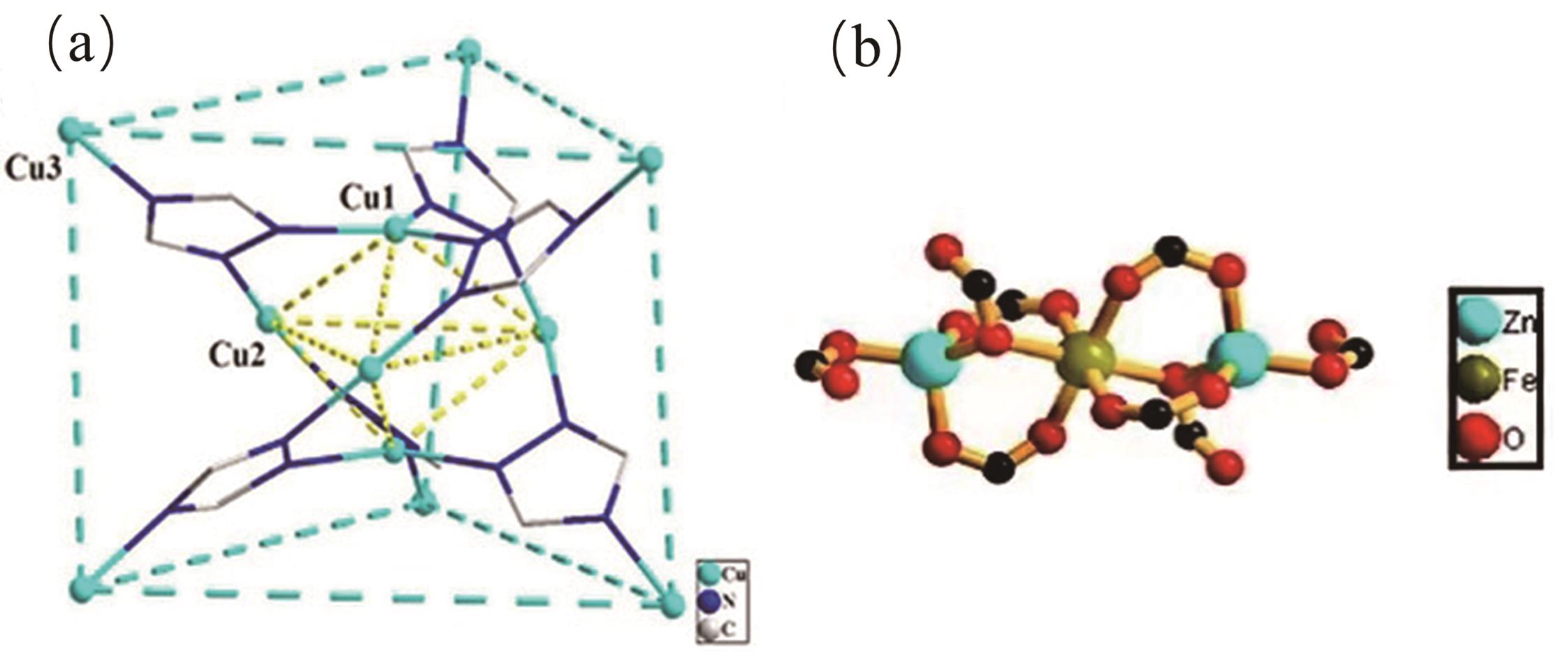
图4 (a)CuTz-1重复单元的三维结构[68]; (b)BMOF的金属配位体结构[69]
Fig.4 (a) Three-dimensional structure of CuTz-1 repeating unit[68]; (b) Metal-coordinated polyhedral structure of BMOF[69]

图5 (a)Ce-MOF-589的晶体结构[13]; (b)PTBMOF和PDBMOF的合成路线图[66]
Fig.5 (a) Crystal structure of Ce-MOF-589[13]; (b) The synthesis routes of PTBMOF and PDBMOF[66]
| Catalysts | Wave length/nm | Mass/mg | Substrates | Concentration | Time | Efficiency/% | Ref. |
|---|---|---|---|---|---|---|---|
| Ce-MOF-589 | - | 1 | MB | 40 mg/L(1 mL) | 15 min | 96 | [ |
| PTBMOF | 200~800 | 20 | Tartrazine | 23 mg/L | 24 h | 98.9 | [ |
| CuTz-1 | 200~800 | 12 | RhB | 12 mg/L(20 mL) | 22 min | 100 | [ |
| BMOF | 200~800 | 10 | MB | 3.7 mg/L | 90 min | 57 | [ |
表2 MOFs材料对有机染料的降解活性
Table 2 Degradation activity of MOFs towards organic dyes
| Catalysts | Wave length/nm | Mass/mg | Substrates | Concentration | Time | Efficiency/% | Ref. |
|---|---|---|---|---|---|---|---|
| Ce-MOF-589 | - | 1 | MB | 40 mg/L(1 mL) | 15 min | 96 | [ |
| PTBMOF | 200~800 | 20 | Tartrazine | 23 mg/L | 24 h | 98.9 | [ |
| CuTz-1 | 200~800 | 12 | RhB | 12 mg/L(20 mL) | 22 min | 100 | [ |
| BMOF | 200~800 | 10 | MB | 3.7 mg/L | 90 min | 57 | [ |
| Catalysts | Light | Mass/mg | Substrate | Concentration | Time | Efficiency/% | Ref. |
|---|---|---|---|---|---|---|---|
| TM-2-d | High pressure mercury lamp(500 W) | 1 000 | MB | 300 mg/L(2 000 mL) | 12 h | 100 | [ |
| ANP | 300~700 nm | 50 | MB | 37 mg/L(20 mL) | 200 min | 97 | [ |
| PCBM | 300~700 nm | 1.2 | RhB | 6.7 mg/mL(3mL) | 30 min | 90 | [ |
表3 有机小分子对有机染料的降解活性
Table 3 Degradation activity of organic small molecules to organic dyes
| Catalysts | Light | Mass/mg | Substrate | Concentration | Time | Efficiency/% | Ref. |
|---|---|---|---|---|---|---|---|
| TM-2-d | High pressure mercury lamp(500 W) | 1 000 | MB | 300 mg/L(2 000 mL) | 12 h | 100 | [ |
| ANP | 300~700 nm | 50 | MB | 37 mg/L(20 mL) | 200 min | 97 | [ |
| PCBM | 300~700 nm | 1.2 | RhB | 6.7 mg/mL(3mL) | 30 min | 90 | [ |
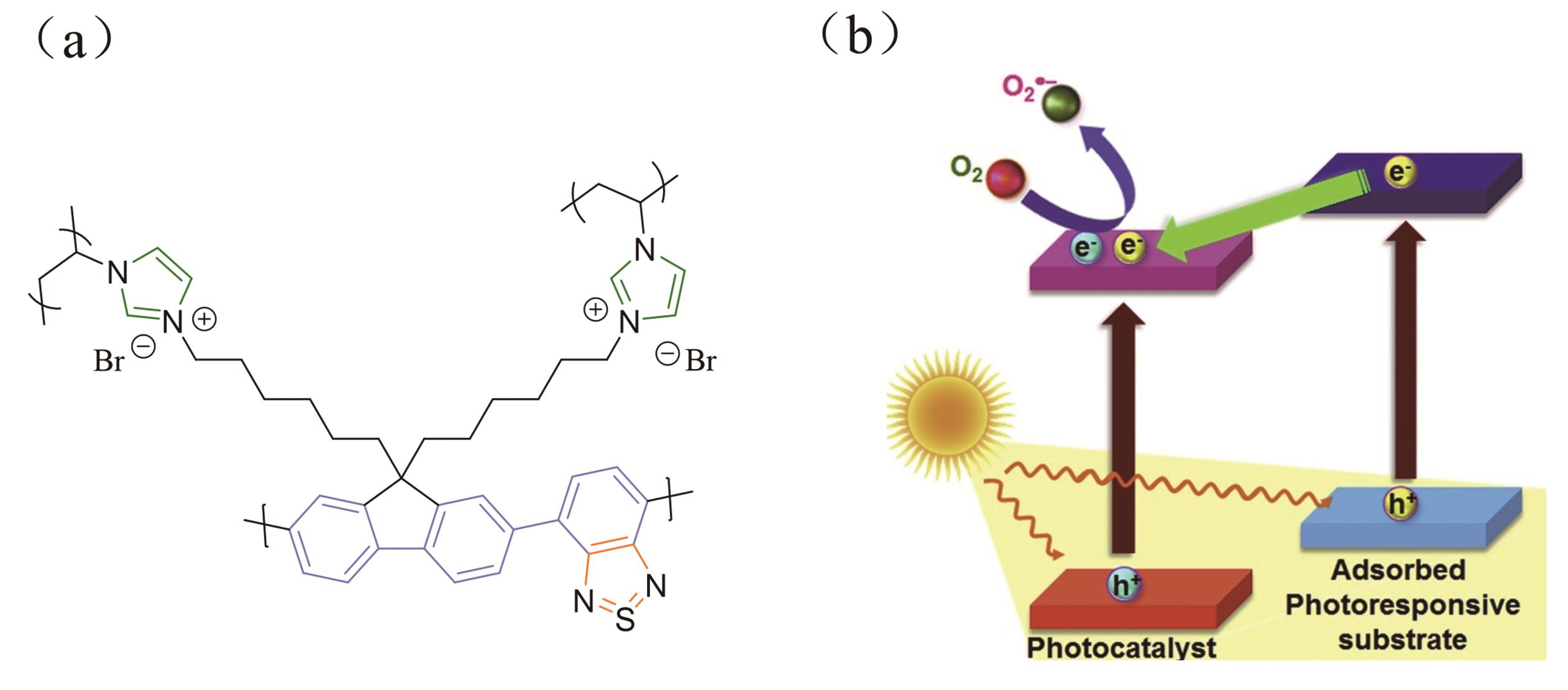
图8 (a)P-FL-BT-3的分子结构[79]; (b)POPs在可见光照射下光催化机理示意图[80]
Fig.8 (a) The molecular structure of P-FL-BT-3[79]; (b) Photocatalytic mechanism demonstrated by POPs working under visible light[80]
| Catalysts | Wavelength | Mass/mg | Substrates | Concentration | Time | Efficiency/% | Ref. |
|---|---|---|---|---|---|---|---|
| 10%TrCMP/TiO2 | 300~700 nm | 26.25 | MB | 8.1 mg/L(35 mL) | 20 min | 92.5 | [ |
| Nano PDPB | λ>450 nm | 3.5 | MO | 3.27 mg/L(3.5 mL) | 240 min | 75 | [ |
| P-FL-BT-3 | 300~700 nm | 1 | RhB | 10 mg/mL(10 mL) | 70 min | 90 | [ |
| POPs-2 | λ>420 nm | 10 | CR | 10 mg/L(10 mL) | 90 min | 85 | [ |
| PTEB | λ>420 nm | 0.3 | RhB | 20 mg/L | 50 min | 100 | [ |
| Py-BF-CMP | λ>450 nm | 4 | RhB | 25 mg/L(20 mL) | 30 min | 81 | [ |
| TZCP-3 | λ>420 nm | 5 | RhB | 10 mg/L(100 mL) | 30 min | 100 | [ |
| TA-BGY | 200~1300 nm | 20 | MB | 30 mg/L(20 mL) | 8 h | 80 | [ |
| TpSD | 300~700 nm | 3 | Rh6G | 10 mg/L(30 mL) | 60 min | 99.2 | [ |
| sp2c-CTP-4 | 300~700 nm | 3 | MB | 40 mg/L(5 mL) | 90 min | 98 | [ |
| network-3 | 300~700 nm | 14.2 | MB | 4 mg/L | 90 min | 95 | [ |
| CTF-NWU-1 | λ>420 nm | 10 | RhB | 20 mg/L(50 mL) | 30 min | 99 | [ |
表4 共轭多孔聚合物材料对有机染料的降解活性
Table 4 Degradation activity of conjugated microporous polymers towards organic dyes
| Catalysts | Wavelength | Mass/mg | Substrates | Concentration | Time | Efficiency/% | Ref. |
|---|---|---|---|---|---|---|---|
| 10%TrCMP/TiO2 | 300~700 nm | 26.25 | MB | 8.1 mg/L(35 mL) | 20 min | 92.5 | [ |
| Nano PDPB | λ>450 nm | 3.5 | MO | 3.27 mg/L(3.5 mL) | 240 min | 75 | [ |
| P-FL-BT-3 | 300~700 nm | 1 | RhB | 10 mg/mL(10 mL) | 70 min | 90 | [ |
| POPs-2 | λ>420 nm | 10 | CR | 10 mg/L(10 mL) | 90 min | 85 | [ |
| PTEB | λ>420 nm | 0.3 | RhB | 20 mg/L | 50 min | 100 | [ |
| Py-BF-CMP | λ>450 nm | 4 | RhB | 25 mg/L(20 mL) | 30 min | 81 | [ |
| TZCP-3 | λ>420 nm | 5 | RhB | 10 mg/L(100 mL) | 30 min | 100 | [ |
| TA-BGY | 200~1300 nm | 20 | MB | 30 mg/L(20 mL) | 8 h | 80 | [ |
| TpSD | 300~700 nm | 3 | Rh6G | 10 mg/L(30 mL) | 60 min | 99.2 | [ |
| sp2c-CTP-4 | 300~700 nm | 3 | MB | 40 mg/L(5 mL) | 90 min | 98 | [ |
| network-3 | 300~700 nm | 14.2 | MB | 4 mg/L | 90 min | 95 | [ |
| CTF-NWU-1 | λ>420 nm | 10 | RhB | 20 mg/L(50 mL) | 30 min | 99 | [ |
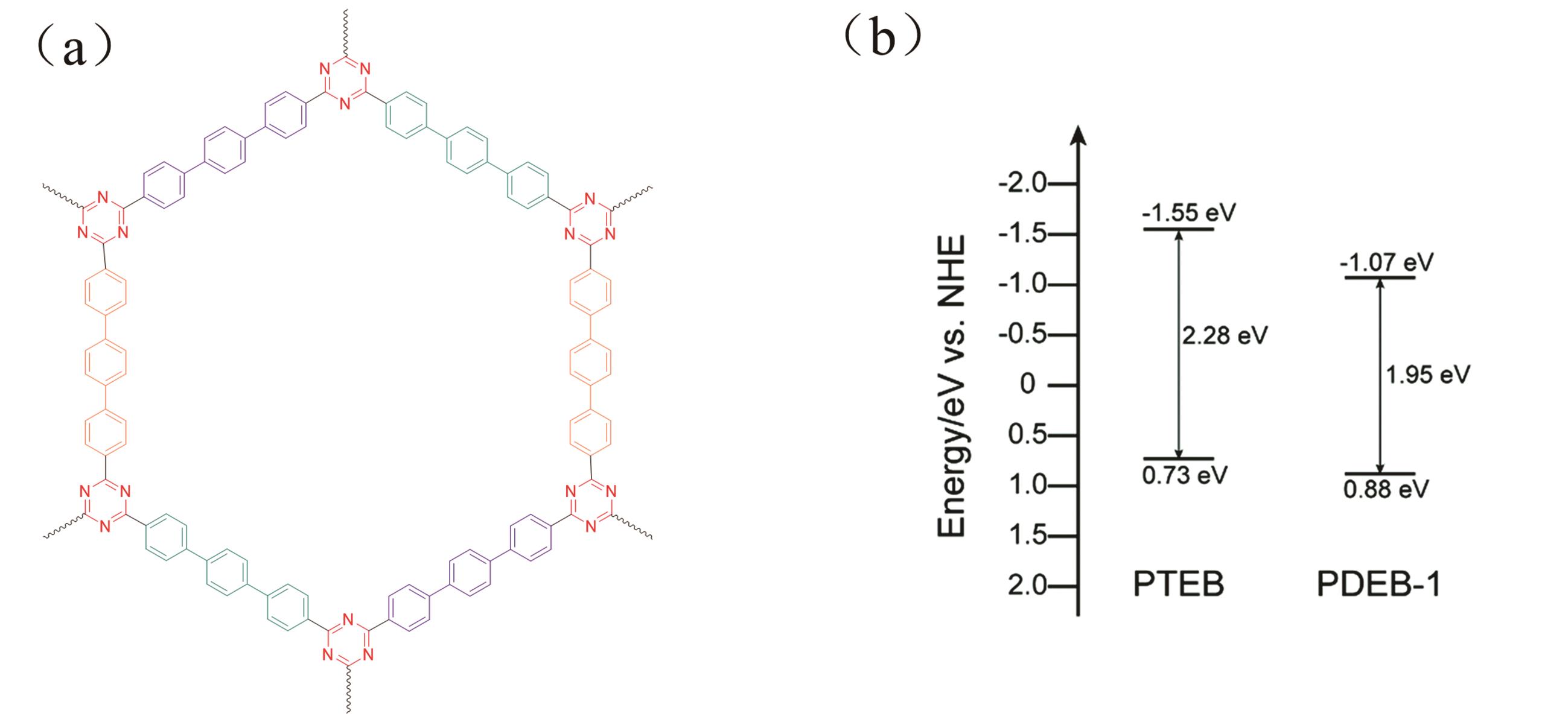
图9 (a)TrCMP的分子结构[31]; (b)PTEB和PDEB-1的HOMO、LUMO能级图[81]
Fig.9 (a) The molecular structure of TrCMP[31]; (b) HOMO and LUMO band positions of PTEB and PDEB-1[81]

图11 (a) TZCP-1、TZCP-2 和 TZCP-3分子单元[83]; (b) TA-BGY的分子结构[84]
Fig.11 (a) The molecular structures of TZCP-1, TZCP-2 and TZCP-3[83]; (b) The molecular structure of TA-BGY[84]
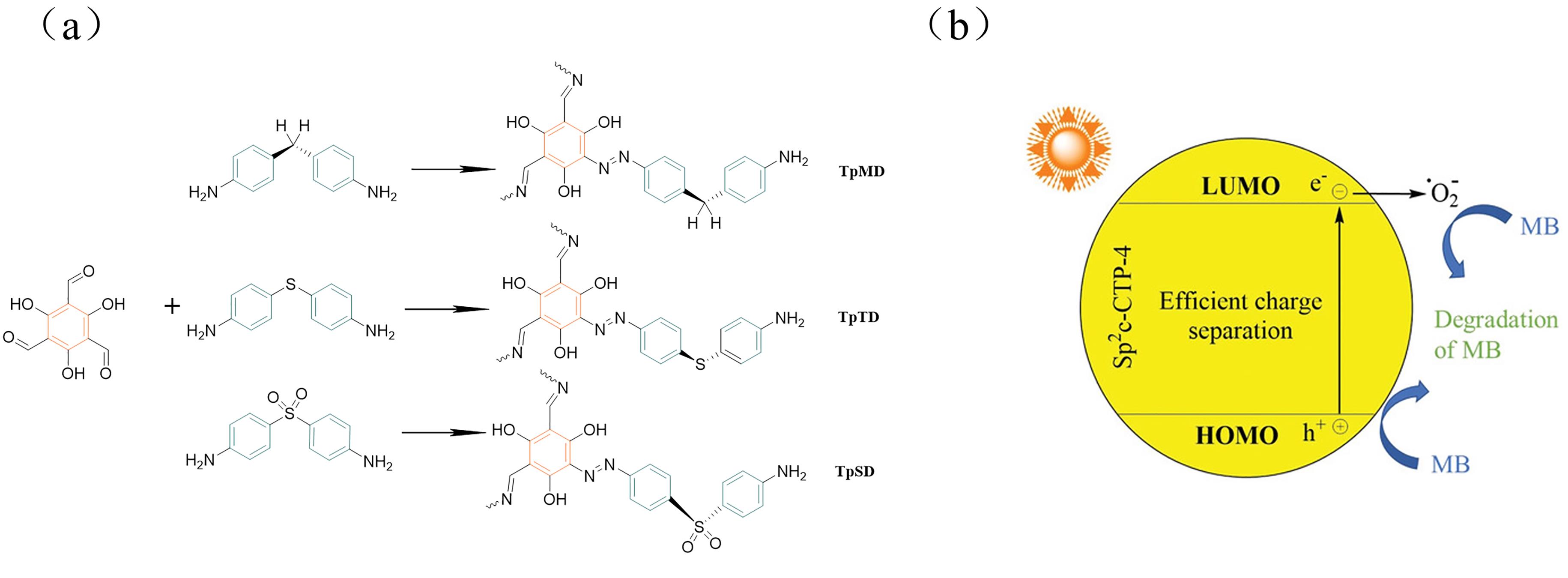
图12 (a) TpSD、TpTD和TpMD对应的合成路线[85]; (b) sp2c-CTP-4催化降解MB的机理[86]
Fig.12 (a) The synthesis routes of TpSD、TpTD and TpMD[85]; (b) The mechanism of MB degradation catalyzed by sp2c-CTP-4[86]
| 1 | LIU H, YANG S, NI Y. Comparison of dye behavior from aspen HYP: dyes added in the HYP manufacturing process versus dyes added at the papermaking wet end[J]. J Wood Chem Technol, 2010, 30(2): 118-128. |
| 2 | FENG Q Y, GAO B Y, YUE Q Y, et al. Flocculation performance of papermaking sludge-based flocculants in different dye wastewater treatment: comparison with commercial lignin and coagulants[J]. Chemosphere, 2021, 262: 128416. |
| 3 | LI Q, DONG K, TU Y, et al. Current situation and problems of MBR treatment process in dye wastewater[C]. IOP Conf Ser: Earth Environ Sci, 2019, 358: 022043. |
| 4 | BELDEAN-GALEA M S, COPACIU F M, COMAN M V. Chromatographic analysis of textile dyes[J]. J AOAC Int, 2018, 101(5): 1353-1370. |
| 5 | UDDIN F. Environmental hazard in textile dyeing wastewater from local textile industry[J]. Cellulose, 2021, 28(17): 10715-10739. |
| 6 | MOYO S, MAKHANYA B P, ZWANE P E. Use of bacterial isolates in the treatment of textile dye wastewater: a review[J]. Heliyon, 2022, 8(6): e09632. |
| 7 | RAMAN C D, KANMANI S. Textile dye degradation using nano zero valent iron: a review[J]. J Environ Manage, 2016, 177: 341-355. |
| 8 | LEE M, NAM K T, KIM J, et al. Evaluation of ocular irritancy of coal-tar dyes used in cosmetics employing reconstructed human cornea-like epithelium and short time exposure tests[J]. Food Chem Toxicol,2017, 108: 236-243. |
| 9 | WARGALA E, SLAWSKA M, ZALEWSKA A, et al. Health effects of dyes, minerals, and vitamins used in cosmetics[J]. Women, 2021, 1: 223-237. |
| 10 | PASDARAN A, AZARPIRA N, HEIDARI R, et al. Effects of some cosmetic dyes and pigments on the proliferation of human foreskin fibroblasts and cellular oxidative stress; potential cytotoxicity of chlorophyllin and indigo carmine on fibroblasts[J]. J Cosmet Dermatol, 2022, 21(9): 3979-3985. |
| 11 | TU Y M, SHAO G Y, ZHANG W J, et al.The degradation of printing and dyeing wastewater by manganese-based catalysts[J]. Sci Total Environ, 2022, 828: 154390. |
| 12 | LIU Z C, KHAN T A, ISLAM M A, et al. A review on the treatment of dyes in printing and dyeing wastewater by plant biomass carbon[J]. Bioresour Technol,2022, 354: 127168. |
| 13 | DANG G H, TRAN Y B N, PHAM T V, et al. A cerium-containing metal-organic framework: synthesis and heterogeneous catalytic activity toward Fenton-like reactions[J]. ChemPlusChem,2019, 84(8): 1046-1051. |
| 14 | ZHANG X, WANG J, DONG X X, et al. Functionalized metal-organic frameworks for photocatalytic degradation of organic pollutants in environment[J]. Chemosphere, 2020, 242: 125144. |
| 15 | ZHAO T C, LIU R, LU J P, et al. Photocatalytic degradation of methylene blue solution by diphenylanthrazoline compounds[J]. J Phys Org Chem, 2017, 30(12): e3712. |
| 16 | ROY A, PRADHAN M, RAY C, et al. Facile synthesis of pyridine intercalated ultra-long V2O5 nanowire from commercial V2O5: catalytic applications in selective dye degradation[J]. CrystEngComm, 2014, 16(33): 7738-7744. |
| 17 | WU W B, MAO D, XU S D, et al. Polymerization-enhanced photosensitization[J]. Chem,2018, 4(8): 1937-1951. |
| 18 | ZHANG S T, WANG Z M, YAO L Z, et al. Preparation of perylene diimide modified AgCl photocatalyst and its photocatalytic performance for degrading various organic pollutants under visible light[J]. Colloids Surfaces A, 2022, 652: 129902. |
| 19 | QU X, LIN J B, QIANG W, et al.Self-doped defect-mediated TiO2 with disordered surface for high-efficiency photodegradation of various pollutants[J]. Chemosphere, 2022, 308: 136239. |
| 20 | ELUMALAI N, PRABHU S, SELVARAJ M, et al. Enhanced photocatalytic activity of ZnO hexagonal tube/r-GO composite on degradation of organic aqueous pollutant and study of charge transport properties[J]. Chemosphere, 2022, 291: 132782. |
| 21 | DAI C H, LIU B. Conjugated polymers for visible-light-driven photocatalysis[J]. Energy Environ Sci, 2020, 13(1): 24-52. |
| 22 | XU X Y, ZHOU X S, ZHANG L L, et al. Photoredox degradation of different water pollutants (MO, RhB, MB, and Cr(Ⅵ)) using Fe-N-S-tri-doped TiO2 nanophotocatalyst prepared by novel chemical method[J]. Mater Res Bull, 2015, 70: 106-113. |
| 23 | MIA M S, YAO P, ZHU X W, et al. Degradation of textile dyes from aqueous solution using tea-polyphenol/Fe loaded waste silk fabrics as Fenton-like catalysts[J]. RSC Adv, 2021, 11(14): 8290-8305. |
| 24 | RANI B, PUNNIYAKOTI S, SAHU N K. Polyol asserted hydrothermal synthesis of SnO2 nanoparticles for the fast adsorption and photocatalytic degradation of methylene blue cationic dye[J]. New J Chem, 2018, 42(2): 943-954. |
| 25 | ROUTOULA E, PATWARDHAN S V. Degradation of anthraquinone dyes from effluents: a review focusing on enzymatic dye degradation with industrial potential[J]. Environ Sci Technol, 2020, 54(2): 647-664. |
| 26 | ZHANG S, LI B F, WANG X X, et al. Recent developments of two-dimensional graphene-based composites in visible-light photocatalysis for eliminating persistent organic pollutants from wastewater[J]. Chem Eng J, 2020, 390: 124642. |
| 27 | KHASAWNEH O F S, PALANIANDY P. Removal of organic pollutants from water by Fe2O3/TiO2 based photocatalytic degradation: a review[J]. Environ Technol Innovation, 2021, 21: 101230. |
| 28 | GAO Z W, PAN C Q, CHOI C H, et al. Continuous-flow photocatalytic microfluidic-reactor for the treatment of aqueous contaminants, simplicity, and complexity: a mini-review[J]. Symmetry, 2021, 13(8): 1325. |
| 29 | JUN L Y, YON L S, MUBARAK N M, et al. An overview of immobilized enzyme technologies for dye and phenolic removal from wastewater[J]. J Environ Chem Eng, 2019, 7(2): 102961. |
| 30 | LI Q, FAN Z L, XUE D X, et al. A multi-dye@MOF composite boosts highly efficient photodegradation of an ultra-stubborn dye reactive blue 21 under visible-light irradiation[J]. J Mater Chem A, 2018, 6(5): 2148-2156. |
| 31 | LI J S, WEN X H, ZHANG Q J, et al. Adsorption and visible-light photodegradation of organic dyes with TiO2/conjugated microporous polymer composites[J]. RSC Adv, 2018, 8(60): 34560-34565. |
| 32 | SHARMA A, DUTTA R K. Studies on the drastic improvement of photocatalytic degradation of acid orange-74 dye by TPPO capped CuO nanoparticles in tandem with suitable electron capturing agents[J]. RSC Adv, 2015, 5(54): 43815-43823. |
| 33 | LESHUK T, HOLMES A B, RANATUNGA D, et al. Magnetic flocculation for nanoparticle separation and catalyst recycling[J]. Environ Sci: Nano, 2018, 5(2): 509-519. |
| 34 | LI S X, HU T Y, XU Y Z, et al. A review on flocculation as an efficient method to harvest energy microalgae: mechanisms, performances, influencing factors and perspectives[J]. Renewable Sustainable Energy Rev, 2020, 131: 110005. |
| 35 | SUN Y J, LI D, LU X, et al. Flocculation of combined contaminants of dye and heavy metal by nano-chitosan flocculants[J]. J Environ Manage, 2021, 299: 113589. |
| 36 | SHI Y Q, YANG Z L, XING L, et al. Recent advances in the biodegradation of azo dyes[J]. World J Microbiol Biotechnol, 2021, 37(8): 137. |
| 37 | DAYI B, ONAC C, KAYA A, et al. New type biomembrane: transport and biodegradation of reactive textile dye[J]. ACS Omega, 2020, 5(17): 9813-9819. |
| 38 | NGUYEN T A, FU C C, JUANG R S. Biosorption and biodegradation of a sulfur dye in high-strength dyeing wastewater by acidithiobacillus thiooxidans[J]. J Environ Manage, 2016, 182: 265-271. |
| 39 | FAN J X, CHEN D Y, LI N J, et al. Adsorption and biodegradation of dye in wastewater with Fe3O4@MIL-100 (Fe) core-shell bio-nanocomposites[J]. Chemosphere, 2018, 191: 315-323. |
| 40 | SUN K, WANG L F, WU C Z, et al. Fabrication of α-Fe2O3@rGO/PAN nanofiber composite membrane for photocatalytic degradation of organic dyes[J]. Adv Mater Interfaces, 2017, 4(24): 1700845. |
| 41 | SUBAIHI A, NAGLAH A M. Facile synthesis and characterization of Fe2O3 nanoparticles using L-lysine and L-serine for efficient photocatalytic degradation of methylene blue dye[J]. Arabian J Chem, 2022, 15: 103613. |
| 42 | HITAM C N C, JALIL A A. A review on exploration of Fe2O3 photocatalyst towards degradation of dyes and organic contaminants[J]. J Environ Manage, 2020, 258: 110050. |
| 43 | LI D W, YU S Y, GENG H J, et al. The (002) exposing facets of WO3 boosting photocatalytic degradation of nitrobenzene[J]. Appl Surf Sci, 2023, 607: 154996. |
| 44 | SHANG Y R, CUI Y P, SHI R X, et al. Depositing Ag3PO4 on WO3 hollow microspheres at room temperature for rapid photocatalytic degradation of rhodamine B[J]. Prog Nat Sci, 2022, 32(3): 282-288. |
| 45 | GAO H G, ZHU L J, PENG X, et al. Fe-doped WO3 nanoplates with excellent bifunctional performances: gas sensing and visible light photocatalytic degradation[J]. Appl Surf Sci, 2022, 592: 153310. |
| 46 | NIE J, LI C Y, JIN Z Y, et al. Fabrication of MCC/Cu2O/GO composite foam with high photocatalytic degradation ability toward methylene blue[J]. Carbohydr Polym, 2019, 223: 115101. |
| 47 | ZHAO Q, WANG K, WANG J L, et al. Cu2O nanoparticle hyper-cross-linked polymer composites for the visible-light photocatalytic degradation of methyl orange[J]. ACS Appl Nano Mater, 2019, 2(5): 2706. |
| 48 | ZHANGA J F, ZHANG Z Q, ZHU W H, et al. Boosted photocatalytic degradation of rhodamine B pollutants with Z-scheme CdS/AgBr-rGO nanocomposite[J]. Appl Surf Sci, 2020, 502: 144275. |
| 49 | HU L X, DENG G H, LU W C, et al. Deposition of CdS nanoparticles on MIL-53(Fe) metal-organic framework with enhanced photocatalytic degradation of RhB under visible light irradiation[J]. Appl Surf Sci, 2017, 410: 401-413. |
| 50 | BAKHTKHOSH P, MEHRIZAD A. Sonochemical synthesis of Sm-doped ZnS nanoparticles for photocatalytic degradation of direct blue 14: experimental design by response surface methodology and development of a kinetics model[J]. J Mol Liq, 2017, 240: 65-73. |
| 51 | WU M H, LI L, LIU N, et al. Molybdenum disulfide (MoS2) as a co-catalyst for photocatalytic degradation of organic contaminants: a review[J]. Process Saf Environ Prot, 2018, 118: 40-58. |
| 52 | ZHOU H, QU W J, WU M, et al. Synthesis of novel BiOBr/Bio-veins composite for photocatalytic degradation of pollutants under visible-light[J]. Surf Interfaces, 2022, 28: 101668. |
| 53 | QU J N, SUN X Y, YANG C L, et al. Novel p-n type polyimide aerogels/BiOBr heterojunction for visible light activated high efficient photocatalytic degradation of organic contaminants[J]. J Alloys Compd, 2022, 900: 163469. |
| 54 | ALANSI A M, AL-QUNAIBIT M, ALADE I O, et al. Visible-light responsive BiOBr nanoparticles loaded on reduced graphene oxide for photocatalytic degradation of dye[J]. J Mol Liq, 2018, 253: 297-304. |
| 55 | NATH I, CHAKRABORTY J, VERPOORT F. Degradation of environmental contaminants by topical heterogeneous photocatalysts[M]. Amsterdam: Elsevier Biomedical Press, 2020: 151-182. |
| 56 | WU M, ZHANG J, LIU C X, et al. Rational design and fabrication of noble-metal-free NixP cocatalyst embedded 3D n-TiO2/g-C3N4 heterojunctions with enhanced photocatalytic hydrogen evolution[J]. ChemCatChem, 2018, 10(14): 3069-3077. |
| 57 | YUAN Y J, LU H W, YU Z T, et al. Noble-metal-free molybdenum disulfide cocatalyst for photocatalytic hydrogen production[J]. ChemSusChem, 2015, 8(24): 4113-4127. |
| 58 | SHEN H D, PEPPEL T, STRUNK J, et al. Photocatalytic reduction of CO2 by metal-free-based materials: recent advances and future perspective[J]. Sol RRL, 2020, 4(8): 1900546. |
| 59 | RAN J R, GUO W W, WANG H L, et al. Metal-free 2D/2D phosphorene/g-C3N4 van der waals heterojunction for highly enhanced visible-light photocatalytic H2 production[J]. Adv Mater, 2018, 30(25): 1800128. |
| 60 | NIKAM L, PANMAND R, KADAM S, et al. Enhanced hydrogen production under visible light source and dye degradation under natural sunlight using nanostructured doped zinc orthotitanates[J]. New J Chem, 2015, 39(5): 3821-3834. |
| 61 | KUSH P, DEORI K, KUMAR A, et al. Efficient hydrogen/oxygen evolution and photocatalytic dye degradation and reduction of aqueous Cr(VI) by surfactant free hydrophilic Cu2ZnSnS4 nanoparticles[J]. J Mater Chem A, 2015, 3(15): 8098-8106. |
| 62 | TALUKDAR S, DUTTA R K. A mechanistic approach for superoxide radicals and singlet oxygen mediated enhanced photocatalytic dye degradation by selenium doped ZnS nanoparticles[J]. RSC Adv, 2016, 6(2): 928-936. |
| 63 | KSHIRSAGAR A S, KHANNA P K. CuSbSe2/TiO2: novel type-II heterojunction nano-photocatalyst[J]. Mater Chem Front, 2019, 3(3): 437-449. |
| 64 | SHEN G D, PU Y P, SUN R J, et al. Enhanced visible light photocatalytic performance of a novel heterostructured Bi4Ti3O12/BiOBr photocatalyst[J]. New J Chem, 2019, 43(33): 12932-12940. |
| 65 | SHEN G D, PU Y P, CUI Y F, et al. Effect of ferroelectric Ba0.8Sr0.2TiO3 on the charge carrier separation of BiOBr at different temperature[J]. Appl Surf Sci, 2021, 550: 149366. |
| 66 | AU V K M, KWAN S Y, LAI M N, et al. Dual-functional mesoporous copper(Ⅱ) metal-organic frameworks for the remediation of organic dyes[J]. Chem Eur J, 2021, 27(35): 9174-9179. |
| 67 | XAMENA F X L, CORMA A, GARCIA H. Applications for metal-organic frameworks (MOFs) as quantum dot semiconductors[J]. J Phys Chem C, 2007, 111(1): 80-85. |
| 68 | LIU C X, ZHANG W H, WANG N, et al. Highly efficient photocatalytic degradation of dyes by a copper triazolate metal-organic framework[J]. Chem Eur J, 2018, 24(63): 16804-16813. |
| 69 | TIWARI A, SAGARA P S, VARMA V, et al. Bimetallic metal organic frameworks as magnetically separable heterogeneous catalyst for efficient organic transformation and photocatalytic dye degradation[J]. ChemPlusChem, 2019, 84(1): 136. |
| 70 | DAI D L, QIU J H, ZHANG L, et al. Amino-functionalized Ti-metal-organic framework decorated BiOI sphere for simultaneous elimination of Cr(VI) and tetracycline[J]. J Colloid Interface Sci, 2022, 607: 933-941. |
| 71 | LIN H D, JIE B R, YE J Y, et al. Recent advance of macroscopic metal-organic frameworks for water treatment: a review[J]. Surf Interfaces, 2023, 36: 102564. |
| 72 | WU M, ZHANG J, LIU C X, et al. Rational design and fabrication of noble-metal-free NixP cocatalyst embedded 3D N-TiO2/g-C3N4 heterojunctions with enhanced photocatalytic hydrogen evolution[J]. ChemCatChem, 2018, 10(14): 3069-3077. |
| 73 | LI X B, XIONG J, GAO X M, et al. Recent advances in 3D g-C3N4 composite photocatalysts for photocatalytic water splitting, degradation of pollutants and CO2 reduction[J]. J Alloys Compd, 2019, 802: 196-209. |
| 74 | NATH K, CHANDRA M, PRADHAN D, et al. Supramolecular organic photocatalyst containing a cubanelike water cluster and donor-acceptor stacks: hydrogen evolution and dye degradation under visible light[J]. ACS Appl Mater Interfaces, 2018, 10(35): 29417-29424. |
| 75 | PORNRUNGROJ C, ONODERA T, OIKAWA H. PCBM nanoparticles as visible-light-driven photocatalysts for photocatalytic decomposition of organic dyes[J]. MRS Commun, 2019, 9(1): 321-326. |
| 76 | MOHAMED M G, ELSAYED M H, ELEWA A M, et al. Pyrene-containing conjugated organic microporous polymers for photocatalytic hydrogen evolution from water[J]. Catal Sci Technol, 2021, 11(6): 2229-2241. |
| 77 | ZHANG Z W, JIA J, ZHI Y F, et al. Porous organic polymers for light-driven organic transformations[J]. Chem Soc Rev, 2022, 51(7): 2444-2490. |
| 78 | GHOSH S, KOUAMÉ N A, RAMOS L, et al. Conducting polymer nanostructures for photocatalysis under visible light[J]. Nat Mater, 2015, 14(5): 505-511. |
| 79 | GHASIMI S, PRESCHER S, WANG Z J, et al. Heterophase photocatalysts from water-soluble conjugated polyelectrolytes: an example of self-initiation under visible light[J]. Angew Chem Int Ed, 2015, 54(48): 14549-14553. |
| 80 | NATHA I, CHAKRABORTYA J, HEYNDERICKXC P M, et al. Engineered synthesis of hierarchical porous organic polymers for visible light and natural sunlight induced rapid degradation of azo, thiazine and fluorescein based dyes in a unique mechanistic pathway[J]. Appl Catal B, 2018, 227: 102-113. |
| 81 | WANG J H, YANG H S, JIANG L, et al. Highly efficient removal of organic pollutants by ultrahigh-surface-area-ethynylbenzene-based conjugated microporous polymers via adsorption-photocatalysis synergy[J]. Catal Sci Technol, 2018, 8(19): 5024-5033. |
| 82 | WANG B, XIE Z, LI Y S, et al. Dual-functional conjugated nanoporous polymers for efficient organic pollutants treatment in water: a synergistic strategy of adsorption and photocatalysis[J]. Macromolecules, 2018, 51(9): 3443-3449. |
| 83 | HUANG Q, GUO L P, WANG N, et al. Layered thiazolo[5,4-d] thiazole-linked conjugated microporous polymers with heteroatom adoption for efficient photocatalysis application[J]. ACS Appl Mater Interfaces, 2019, 11(17): 15861-15868. |
| 84 | CHEN T, LI W Q, CHEN X J, et al. A triazine-based analogue of graphyne: scalable synthesis and applications in photocatalytic dye degradation and bacterial inactivation[J]. Chem Eur J, 2020, 26(10): 2269-2275. |
| 85 | CAO Y P, LIU W, QIAN J, et al. Porous organic polymers containing a sulfur skeleton for visible light degradation of organic dyes[J]. Chem Asian J, 2019, 14(16): 2883-2888. |
| 86 | XU C, XIE Q J, ZHANG W J, et al. A vinylene-bridged conjugated covalent triazine polymer as a visible-light-active photocatalyst for degradation of methylene blue[J]. Macromol Rapid Commun, 2020, 41(7): 2000006. |
| 87 | CHAE J A, JEONG S, KIM H J, et al. Fibrous mesoporous polymer monoliths: macromolecular design and enhanced photocatalytic degradation of aromatic dyes[J]. Polym Chem, 2021, 12(16): 2464-2470. |
| 88 | WANG H, GUAN L J, LIU J W, et al. A thiazolo[5,4-d]thiazole functionalized covalent triazine framework showing superior photocatalytic activity for hydrogen production and dye degradation[J]. J Mater Chem A, 2022, 10(30): 16328-16336. |
| [1] | 元宁, 马洁, 张晋玲, 张建胜. 蒸气辅助合成PCN-6(M)双金属有机框架材料及其CH4和CO2吸附性能[J]. 应用化学, 2023, 40(6): 896-903. |
| [2] | 王华宇, 张超, 陈柯铭, 葛明. 金属-有机框架MIL-88A(Fe)及其复合材料在水处理中的研究进展[J]. 应用化学, 2023, 40(2): 155-168. |
| [3] | 刘盛杰, 叶永杰, 刘银怡, 林淑满, 谢浩源, 刘文婷, 许伟钦. 基于泡沫铜的多孔碳均匀负载Cu3P纳米颗粒的制备及其光催化降解染料性能[J]. 应用化学, 2022, 39(7): 1090-1097. |
| [4] | 邵姗, 张剑, 邓凯强, 杨杰, 杨绍明. 镍钴双金属-卟啉有机框架复合纳米材料构建的无酶传感器检测多巴胺[J]. 应用化学, 2022, 39(7): 1098-1107. |
| [5] | 张晓丽, 彭玉美, 王庆伟, 秦利霞, 刘肖霞, 康诗钊, 李向清. 纳米Ag/TiO2纳米管阵列基底构建及表面增强拉曼散射光谱检测与降解盐酸四环素[J]. 应用化学, 2022, 39(7): 1147-1156. |
| [6] | 徐一鑫, 王爽, 全静, 高婉婷, 宋天群, 杨梅. 二硫化钼量子点/还原氧化石墨烯复合材料的制备及其光催化降解有机染料、四环素和Cr(VI)[J]. 应用化学, 2022, 39(5): 769-778. |
| [7] | 商林杰, 刘江, 兰亚乾. 共价有机框架材料用于光/电催化CO2还原的研究进展[J]. 应用化学, 2022, 39(4): 559-584. |
| [8] | 王佳赫, 刘大勇, 刘伟, 王林, 董彪. 纳米TiO2光催化抗菌应用的研究进展[J]. 应用化学, 2022, 39(4): 629-646. |
| [9] | 黄小梅, 邓祥, 邢浪漫, 陈伟, 孙莉, 朱晓玉. Cu(Ⅱ)Co(Ⅱ)双金属碳纳米片用于无酶葡萄糖传感器[J]. 应用化学, 2022, 39(12): 1891-1902. |
| [10] | 逯慧, 李江, 王丽华, 诸颖, 陈静. 原子级精确的币金属纳米团簇在光催化应用方面的研究进展[J]. 应用化学, 2022, 39(11): 1652-1664. |
| [11] | 叶祥志, 邓云水, 刘源, 周咏柳, 贺建雄, 熊春荣. 玻璃球负载非晶态有机钛聚合物提高光催化还原CO2的转换频率[J]. 应用化学, 2022, 39(10): 1554-1563. |
| [12] | 周玉凤, 周川巍, 胡桐泽, 段展鹏, 王颢潼, 石淑云. Fe/V-Sb2O3复合材料的构筑及光催化降解医药废水[J]. 应用化学, 2022, 39(10): 1572-1578. |
| [13] | 杨玉萍, 徐绍红, 马国扬, 焦黎明, 孙莉萍, 夏然. 5-氘代利巴韦林衍生物的合成[J]. 应用化学, 2021, 38(8): 911-916. |
| [14] | 赵星鹏, 王娅乔, 高生旺, 朱建超王国英, 夏训峰, 王洪良, 王书平. BiOBr/CeO2复合材料的制备及光催化降解磺胺异恶唑[J]. 应用化学, 2021, 38(4): 422-430. |
| [15] | 唐飞, 杜多勤, 谭芸妃, 秦莉晓. 正六棱型MoO3-x微米柱光催化剂的制备及性能[J]. 应用化学, 2021, 38(1): 92-98. |
| 阅读次数 | ||||||
|
全文 |
|
|||||
|
摘要 |
|
|||||
